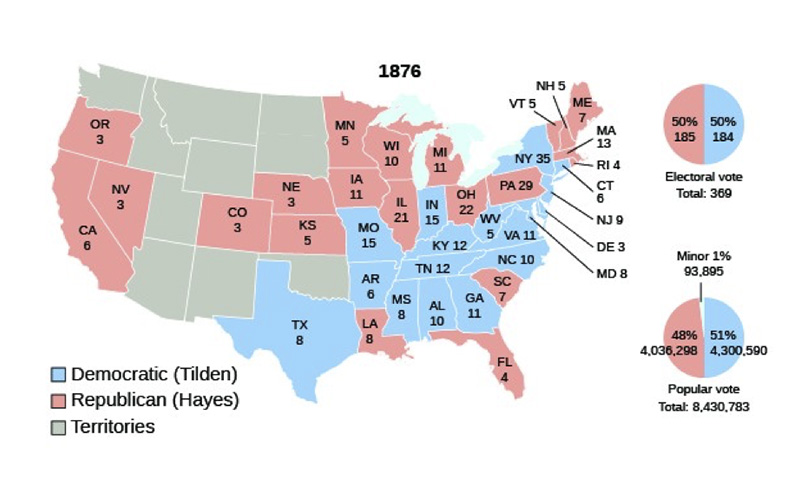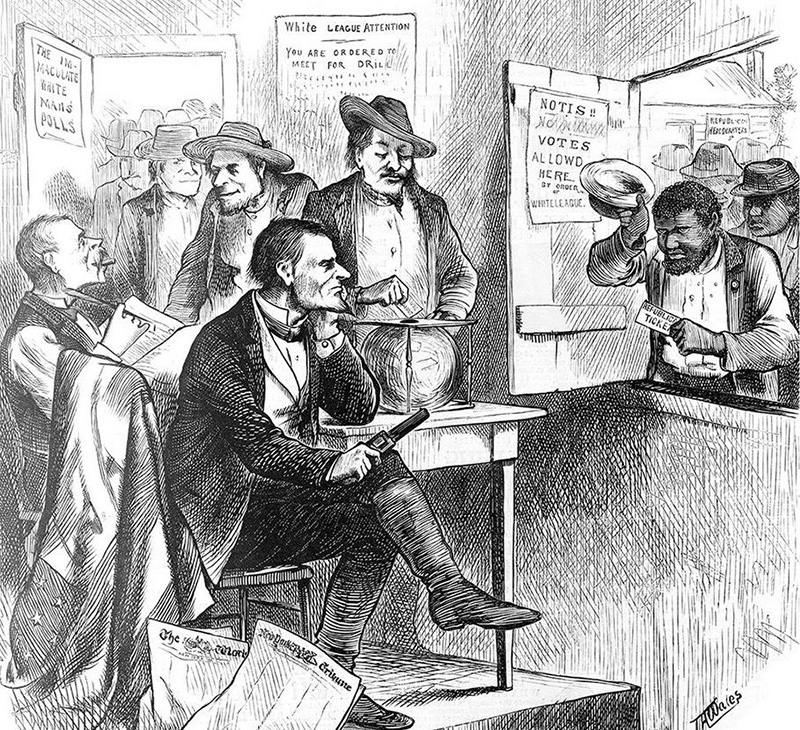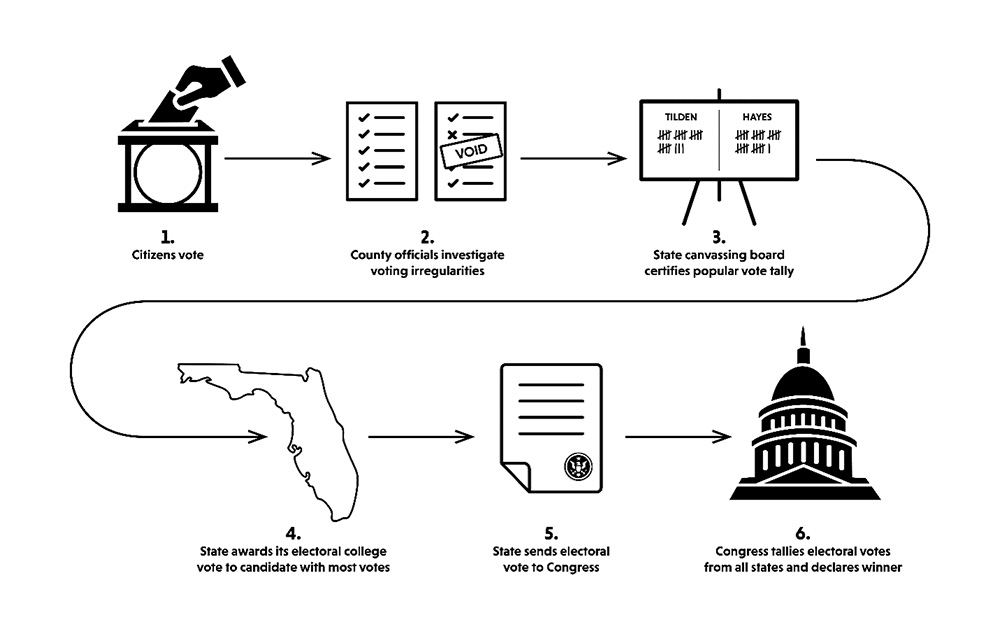Lesson Plan: Basic High School
Time: One Hour
Objective: Students will study the 1876 Presidential Election and analyze a map, cartoon, graphic, primary source document and engage in a group exercise.
Preparation: Have students watch this 15-minute video to prepare as homework:
1. Activity: Map Reading Skills
Electoral Vote Map for 1876 Presidential Election

Questions for Students:
- How many total electoral votes were there in 1876?
- Why are there areas in this map that are shaded grey?
- Which candidate won the Electoral Vote?
- Which candidate won the Popular Vote?
- Which candidate was favored by the Southern states?
- The electoral votes from Florida, Louisiana, South Carolina and one of the three electors from Oregon were contested. How many total electoral votes were thus contested?
- If Tilden had been awarded the votes from the contested states, how many total electoral votes would he have received? How many would Hayes have received?
2. Activity: Map Reading Skills
Students will first watch chapter 3 “The Party Divide” and then interpret this cartoon:

- Which amendment gave Black men get the right to vote in the U.S.? What year was it passed?
- Which party is the Black voter trying to vote for (see ballot in hand)? Did most Black citizens favor this party and why?
- Which party does the man with the pistol represent and which states would he be likely to be from?
- Why did Southern vigilantes use threats of violence to suppress Black voters during Reconstruction?
3. Activity: Interpreting a Graphic
The Electoral College was invented by the framers of the Constitution as a compromise between those who favored letting Congress select the executive and those who advocated direct popular election. (However, the term “electoral college” does not appear in the Constitution.) Have students watch Chapter 6 “Disputed Votes” and then answer the questions below about this graphic:

- This graphic shows the normal procedure for a presidential election. Which numbers did not happen as expected in the 1876 election?
- Look at graphic #3. What was the role of the state canvassing boards in the contested states of Florida, South Carolina and Louisiana and which party did they favor?
- What went wrong with step #5? Why did the contested states send two sets of electoral votes to Congress?
4. Examining a Document:
The Twelfth Amendment (Amendment XII)
The Twelfth Amendment (Amendment XII) to the United States Constitution was passed in 1804 and replaced the procedure provided in Article II, Section 1, Clause 3 for electing a President and Vice President. Have students watch Chapter 7 of the video “The Electoral Commission” and then answer questions about the text below:
The Electors shall meet in their respective states, and vote by ballot for President and Vice-President, one of whom, at least, shall not be an inhabitant of the same state with themselves; they shall name in their ballots the person voted for as President, and in distinct ballots the person voted for as Vice-President, and they shall make distinct lists of all persons voted for as President, and all persons voted for as Vice-President and of the number of votes for each, which lists they shall sign and certify, and transmit sealed to the seat of the government of the United States, directed to the President of the Senate;
The President of the Senate shall, in the presence of the Senate and House of Representatives, open all the certificates and the votes shall then be counted;
The person having the greatest number of votes for President, shall be the President, if such number be a majority of the whole number of Electors appointed; and if no person have such majority, then from the persons having the highest numbers not exceeding three on the list of those voted for as President, the House of Representatives shall choose immediately, by ballot, the President. But in choosing the President, the votes shall be taken by states, the representation from each state having one vote; a quorum for this purpose shall consist of a member or members from two-thirds of the states, and a majority of all the states shall be necessary to a choice….
- What does the red underlined portion say? Who was president of the Senate in 1876? What party did he represent?Does the text indicate precisely who should count the votes?
- Which party had a majority in the Senate? Which party had a majority in the House of Representatives?
- Why didn’t the House of Representatives want the President of the Senate to be the one to decide whether to accept the Republican or Democrat electoral votes from the contested states? (Tell students that the Republicans in the Senate argued in favor of the Senate’s right to count the disputed electoral votes, while the Democrats in the House argued that only the two houses acting together could determine which votes were legitimate.)
- The Republican-controlled Senate and the Democratic-controlled House quarreled over who should determine which electoral returns from the three southern states to accept. Why was it so difficult for Congress to resolve the issue of which candidate had the most electoral votes?
- What does the blue underlined portion say? How does what happened in the 1876 Election differ from the text?
- What was the compromise solution between the House and the Senate to resolve who should decide how to count the electoral votes from the disputed states?
5. Activity: Group Exercise
Watch in class chapters 9 and 11 “The Dilemma” and “The Casting Vote.”
- Divide students into three groups. Have one group be the lawyers for the Democratic Party arguing before the Electoral Commission and ask them to write down their argument. Have another group be the Republican lawyers and ask them to write down their argument. Have the third group be the Electoral Commission and decide amongst what procedure they will use for deciding on the outcome (oral vote, written vote, electing a leader to announce result)
- Have one member from the Democrats and Republicans read their party’s statements. Then have the Electoral Commission members deliberate, discuss Justice Joseph Bradley’s ruling, and determine which candidate should be awarded the disputed electoral votes.
- Conclusion: Remind students that ten years later, in 1887, legislation was passed that gives final authority to each state to decide on the legality of a set of electoral votes. This legislation, which is still current, also requires a concurrent majority of both the Senate and the House of Representatives to reject any disputed electoral vote so the problems in the 1876 election did not happen again. Ask students what they think that were the pros and cons of having an Electoral Commission resolve the election dispute.
Lesson Plans AP US History
(to supplement basic lesson plan above)
Research Exercise:
Inform students that the election of Rutherford B. Hayes is often referred to as part of the Compromise of 1877. Some historians claim that the Democrats, who were in control of the House, agreed to the election of Hayes in exchange for the end of Reconstruction. At a meeting at the Wormley hotel in February 1877 Democrats extracted three campaign promises from the Republicans.
- Have students research who attended the meeting.
- Have them outline what three promises were made (withdrawal of troops from the South, the appointment of at least one southerner to the Cabinet, and substantial appropriations for Southern internal improvements).
- Ask them to find out when and to what extent those promises were fulfilled.
- Ask them to research how withdrawing the troops permitted Southern states to impose racial segregation and disenfranchise Black voters.
- Ask them to find historians’ arguments disputing the importance of the Compromise of 1877 in Hayes’ election and evaluate those arguments.
2. Relating Past to Present
The 1876 Election is one of only 5 elections (1824, 1876, 1888, 2000, 2016) where the popular vote winner was defeated. The Supreme Court played a decisive role in determining the outcome of the 2000 election of George W. Bush., but with significant differences from the 1876 Election, where five Justices also played an important role.
A. Read this summary of the Election of 2000 (from Bill of Rights Institute)
On the evening of November 7, 2000, many Americans went to sleep believing they knew who would be President of the United States for the next four years. But they woke up to find themselves, along with the rest of the nation, in a kind of limbo which would last more than a month. Who had won the election of 2000: Texas Governor George W. Bush, or Vice President Al Gore? News stations projected Gore as the winner of Florida by 8pm. But by 10pm, those same stations took back their projections. By 2am, Bush was in the lead in Florida, and the television networks declared him the winner. But not long after that, Florida changed to “too close to call” with Bush leading Gore by 1,784 votes (2,909,135 to 2,907,351). Nationally, Bush had won 246 electoral votes; Gore had won 260. The number of electoral votes needed to win the election is 270. Florida’s twenty-five electoral votes hung in the balance. The outcome of the election would depend on how Florida voted.
Florida election law called for an automatic machine recount when the margin of victory was less than one half of one percent. After the machine recount, Bush’s lead was down to 327 votes. As allowed under Florida law, Gore requested hand recounts of ballots in Palm Beach, Broward, Miami-Dade, and Volusia counties. About 1.8 million votes had been cast in these heavily Democratic counties. Florida Law Florida law permitted the manual recounts. The law also required counties to deliver their results to the Florida Secretary of State by November 14. Some counties said this was not enough time. To further complicate things, Florida had two statutes about late vote counts which seemed to contradict each other. One statute said the Secretary of State “shall” ignore late returns; the other statute said the Secretary “may” ignore late returns. Florida Secretary of State Katherine Harris— who was also the co-chairman of Bush’s Florida campaign—said she would not take results submitted after the legal deadline. Gore filed suit to force Harris to accept the late returns. Bush and Secretary of State Harris asked the Florida Supreme Court to block the recounts, but the Court refused. The Florida Supreme Court ordered Harris not to certify the state’s election results until an emergency hearing could take place.
The Florida Supreme Court ruled (7-0) that the recounts should continue. Further, the Court ordered that the votes had to be counted in the state’s totals despite the deadline in Florida law. The Court set a deadline of 5pm on November 26 for counties to submit their totals. Florida Governor Jeb Bush—brother of George W. Bush—asked the US Supreme Court to review the Florida high court’s ruling. In Bush v. Palm Beach County Canvassing Board, the Supreme Court unanimously held that there was “considerable uncertainty as to the precise grounds for the decision.” The Supreme Court sent the case back to Florida with questions for the state Supreme Court. Miami-Dade County officials stopped their manual recount, leaving 9,000 votes not counted; Palm Beach County had about 1,000 votes left to count by the 5pm deadline on November 26. Harris turned down the county’s request for an extension and rejected the partial vote count that had been submitted by the deadline.
On November 26, the deadline set by the Florida Supreme Court, Harris certified the results of the election: Bush had won Florida and, therefore, the Presidency. With the election results now certified, Gore officially contested the Florida election results. He challenged the results in Palm Beach and two other counties. While all these arguments were taking place in the court system, the Florida legislature called a special session to consider whether to appoint the state’s electors itself. It did not do so. The Florida Supreme Court reasoned that accuracy was more important than finality, and ordered a statewide manual recount. The vote was 4-3. Neither Bush nor Gore had asked for a state-wide recount. The statewide recount was halted the next day by the US Supreme Court, which issued a stay (an order to stop until a hearing can take place). The case would go before the US Supreme Court on December 11—a week before the Electoral College was set to cast its votes. The question before the US Supreme Court would be: Did the Florida Supreme Court exceed its authority by ordering a state-wide manual recount? And, would such a recount be constitutional?
George W. Bush argued that a statewide manual recount would violate the United States Constitution’s Fourteenth Amendment. The Fourteenth Amendment says that “no state shall … deny to any person within its jurisdiction the equal protection of the laws.” Since counties were using different standards to decide which votes would count, Bush argued that Florida was not treating all its citizens equally under the law. Gore argued that there was a uniform standard for re-counting votes. The standard, as stated in Florida statute, was that a vote would count if the clear intent of the voter was reflected in the ballot. Gore also pointed out that there were five times as many “undervotes” (votes where machines registered no vote for President) in punch-card counties than in counties with optical voting machines. Therefore, he argued, the recount standard would actually be more uniform than the standards applied on Election Day. The Supreme Court agreed with Bush and ruled (5-4) to halt the manual recounts. Therefore, the Florida results as certified by the Secretary of State were final, and George W. Bush became the forty-third President of the United States, taking the oath of office on January 20, as specified in the Twentieth Amendment.
B. Answer These Comprehension and Critical Thinking Questions:
- What state was at the center of the presidential election controversy in 2000? Was that state also involved in the 1876 election dispute?
- What was the significance of the November 26 deadline set by the Florida Supreme Court?
- What did the Florida Supreme Court order in response to Gore’s challenge of the Florida election results?
- What was Bush’s argument before the Supreme Court? What was Gore’s argument?
- How did the Supreme Court rule in Bush v. Gore (2000)?
- Name 3 similarities with the 1876 Presidential Election:
(No winner declared immediately after the election; charges of voter intimidation and vote rigging; state officials awarded the state’s electoral votes to the Republican candidate and Democrats challenged the result; both elections were decided by a single vote, cast by a Republican Supreme Court justice; the recounting of votes was denied in both elections; the winner of the national popular vote lost.) - Name 3 differences:
(The 2000 election involved disputed votes in only one state; the 2000 election was decided in December as opposed to March in 1876; the 2000 election was decided by suits in the state court system and in federal court whereas the 1876 election was given to a commission made up of members of Congress and Supreme Court justices.)




